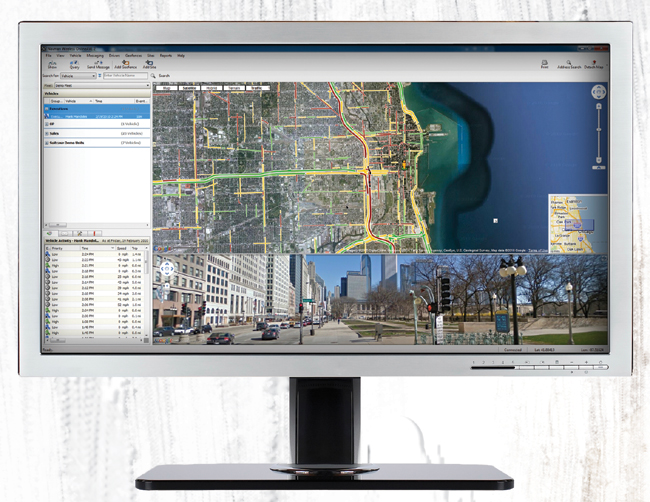Idling & Maintenance Control
In the world of equipment maintenance, what you don’t know can cost you. Consider the case of one mining company that kept a compact wheel loader running all day to pick up overburden. When asset managers installed a GPS tracking device that also captured data on machine movement, they learned that a staggering 72 percent of the machine’s ignition-on time was spent idling. That information triggered new operations policies that yielded nearly $20,000 in annual fuel savings for that machine alone, plus maintenance benefits like reduced engine wear.
 |
| For construction vehicles, idling typically accounts for 20 to 40 percent of the work day. This not only wastes millions of dollars in fuel, but also risks the wrath of your boss and environmental regulators. |
In another case, a construction company using GPS tracking and associated fleet management software discovered that its equipment was being over-lubed largely because engine hours were not being recorded accurately by hand. The company was able to chop lube work by 30 percent — saving tens of thousands of dollars a year in labor, oil and oil filters — through the system’s ability to accurately log machine hours, apply them to maintenance status reports and flag machines ready for their 250-hour lube job.
In fact, GPS-based fleet management software typically helps operators cut idling time by at least 50 percent, eliminate both under- and over-maintenance, and even thwarting thieves because the companion GPS tracking device can pinpoint the location of stolen equipment. Here’s a quick snapshot of how it works.
Controlling Idling
For construction vehicles, idling typically accounts for 20 to 40 percent of the work day. This not only wastes millions of dollars in fuel, but also risks the wrath of environmental regulators concerned about the release of carcinogenic diesel exhaust.
In California, for example, idling a diesel-powered machine for more than five minutes can result in a $300 ticket per occurrence or a fine of up to $10,000 for a machine with multiple violations. Nearly 30 states have announced that they will adopt similar laws.
Many of today’s GPS-based fleet tracking systems can measure idling vs. work time — either by lack of movement when the ignition is on or by connection to sensors that measure engine revolutions based on oil pressure — and deliver the results in standard reports available from a dropdown menu. This is the only practical way to ascertain idling rates and by association understand the extent of the waste.
Whether managers respond by training operators to shut the machine off when it is not in use or by installing idle timers that automatically kill the engine after a specific interval of non-productive engine operation, the resulting reduction in idling can lead to fuel savings, reduced risk of regulatory penalties and longer use of the machine.
Managing Preventive Maintenance Schedules
One of the major challenges in maintaining equipment is knowing when it needs to be serviced. The problem with the usual method of tracking engine hours — asking the oiler to read the hour meter whenever he fuels the machine — is that he typically works in the dark and can easily misrecord the number or misplace a decimal point. The task also takes time away from his fueling, greasing and inspection duties. The wrong data can then be transferred to a spreadsheet or the right data entered wrongly by human error.
With a GPS tracking device installed in the machine, the hours-of-operation data is automatically transmitted to the fleet management software and used to produce continually updated maintenance status reports. The software can also alert managers when a given machine is due for any maintenance activity ranging from an oil change to a complete undercarriage inspection.
The specific maintenance jobs and the desired service intervals are defined when the equipment maintenance manager sets up the system. Maintenance status is identified as due, coming due or overdue; sometimes by color-coded icons. Most importantly, the accurate electronic capture of engine hours avoids the extra expense of servicing too early, as well as the potential complications of servicing too late. If a contractor usually does an oil change every 90 days but work has been unusually slow or the machines are working double shifts because of pressing deadlines or other scenarios, the system will automatically adjust maintenance due dates accordingly.
 |
| OnlineAVL2 (automatic vehicle locator) is Navman Wireless’ latest GPS fleet management software application. OnlineAVL2 provides you the tools to monitor, manage and communicate with your assets and vehicles, and a full reporting suite lets you download and review reports. |
Fringe Benefits
There are other benefits too. With air inlet restriction sensors attached to the GPS tracking device, managers can tell if the machines on a dusty construction site require more frequent air filter changes. By checking equipment activity reports showing current work schedules by machine, mechanics can determine when machines will be free for maintenance. With the system’s real-time GPS location abilities, those same mechanics can find machines that are due to be serviced simply by logging in and looking at the locator map. If a machine is stolen, the GPS tracker can find it.
Even the basic idling and maintenance controls, however, are worth their weight in machinery. In addition to saving fuel and keeping the environmental police at bay, less idling translates to less wear and tear, longer machine life, higher resale value and longer intervals between maintenance sessions. Optimizing maintenance schedules through accurate logging of engine hours and at-a-glance maintenance status reports results in fewer breakdowns, fewer unnecessary maintenance cycles and better equipment operation.
If you thought that GPS technology was only for getting from Point A to Point B, there’s obviously a whole lot more going on under the hood.
Renaat Ver Eecke is vice president and general manager of North America for Navman Wireless, based in Glenview, Ill.

Comments are closed here.